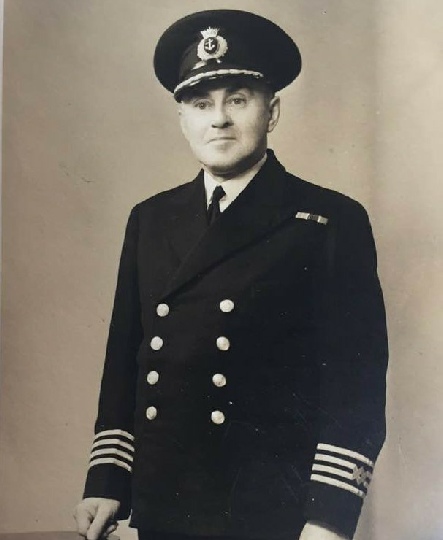SUPPLEMENT TO THE LONDON GAZETTE, 29 OCTOBER, 1918. 12697
The names of the following have been brought to notice by the Secretary of State for War for valuable services rendered on the occasion of the sinking or damage by enemy action of Military Hospital -Ships and Transports: —
Capt Edward Weatherstone Day (Hospital Ship " Glenart Castle ").
Capt John Barry Whitton (Hospital Ship "Goorkha").
Capt John Vyvyan Watson-Black (Hospital Ship " Galeka").
Ch. Offr. James Disraeli Kerridge (Hospital Ship " Glenart Castle ").
Ch. Ofifr. Sidney Godolphin Symons (Hospital Ship " Goorkha").
1st Offr. Hugh Wilson Douglas Wilson (HospitalShip "Galeka").
3rd Offr. Matthew Henry Williams (Hospital Ship " Galeka").
2nd Std. Henry Welsh (Hospital Ship " Galeka ").

|
Service Record
|
From
|
To
|
|
Joined Company
|
1/1912
|
|
|
Galeka
4th Officer
|
9/1914
|
|
|
Galeka
3rd Officer
|
9/1918
|
|
|
Rowallan Castle
Master
|
3/1939
|
2/1940
|
|
Dundrum Castle
Master
|
2/1940
|
10/1941
|
|
Llanstephan Castle
Master
|
11/1941
|
9/1942
|
|
Dunnottar Castle
Master
|
9/1942
|
1/1943
|
|
Llangibby Castle
Master
|
4/1943
|
5/1944
|
|
Llangibby Castle
Master
|
8/1944
|
11/1944
|
|
Carnarvon Castle
Master
|
12/1944
|
11/1946
|
|
Retired
|
4/1947
|
|
|
Died
|
2nd September 1960
|
Aged 78
|
From the Union-Castle Chronicle by Marischal Murray.
Before the war one or two less distinguished vessels in the Union-Castle fleet were general cargo carriers, pure and simple. Their hulls were not painted lavender grey, but black. The Dundrum Castle, 5,299 tons, was one of thee prosaic cargo ships. If her career, hitherto, had been undramatic, this was soon to change. In June, 1940, the Dundrum Castle (Captain M.H. Williams) lay at St. Nazaire, in France, while all around the world seemed to be crashing down.
The Dundrum Castle had been at St. Nazaire for several days. On board was military cargo for discharge at Dunkirk. Dunkirk as a port of discharge was about to vanish from the map. At St. Nazaire the German planes were flying over. The Dundrum Castle with her A.A. guns joined in the battle. On Monday, June 17th, instructions came that the vessel was to get out of the port at 2 o'clock that afternoon. She was just about to sail when 500 troops and a few civilian refugees were hurriedly put on board. Somewhat delayed the vessel left her berth, proceeded to the lock, and then entered the river, bound for the Channel and shores of Britain. She was to get no further on that terrible afternoon.
It was just after 4 p.m. that German aircraft came over and attacked the shipping in the harbour. In addition to the Dundrum Castle there was a large liner about to leave for England. She was the Lancastria, well-known on the North Atlantic in the days before the war. On board her now were 5,000 British troops, men of the B.E.F. (British Expeditionary Force) lucky to be getting out of France. The Germans scored a direct hit on the Lancastria; the stricken vessel turned slowly over on her side and sank; the water that surrounded her became a mass of blazing oil. 3,000 men perished in the inferno.
At all possible speed the Dundrum Castle made for the scene of the disaster, joining with other craft in such work of rescue as was possible. Two of her lifeboats were manned and sent away, one in charge of Mr. D.P.H. Klasen, Chief Officer, the other in charge of Mr. W.G. Shannon, 2nd Officer. To save many lives was quite impossible, and the work of rescue was slow and painful. The water was thick with fuel oil from the sunken ship, and to drag even a single survivor into the lifeboats took considerable time. The Dundrum Castle's lifeboats were the last to leave this scene of horror, and the crews were exhausted when they got back to their ship. By their efforts over 120 lives were saved. It was not possible for the Dundrum Castle to leave the anchorage at St. Nazaire that night, but at 11 p.m. Captain Williams was signalled by a British destroyer to join up with the next convoy going out. The Dundrum Castle joined the convoy and on June 20th she landed her 500 troops and the refugees in the safety of Southampton.'
Captain Williams was master of the "Llangibby Castle" when in July 1943 in company with the "Durban" and "Winchester" Castles she was involved with the allied landings on Sicily, then onto Salerno and Anzio.
In mid-March 1943 the "Llangibby Castle" was given a refit in preparation for the "D" day landings, shortly before which Captain Williams was given compassionate leave and relieved by Captain T.W. McAllen.

HMHS Galeka - 1918
Dundrum Castle - 1940
Obituary - 1960

Capt Matthew Williams
“Washer”









